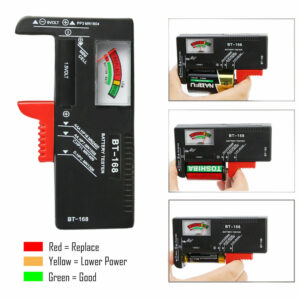AA, AAA, C, D, 9V Button Cell Voltage Battery Tester Testing Check Checking Tool
$13.73
500 in stock
The tester has three ranges, `Good’ (green), Low (yellow), and `Replace’ (red). The sliding red contact is adjusted manually.
The tester is designed to work with various types of 1.5 volt batteries (AAA, AA, C, D, disc or button type). Do not try testing a battery of a higher voltage, as you may fry a resistor, blow a fuse, or otherwise damage the tester. There is a separate set of contacts for testing 9 volt batteries.
To precisely measure a battery’s actual output, a voltmeter would be used. A tester like the BT20 only provides a rough idea of battery strength. A new 1.5 volt, non-rechargeable battery, delivering the full 1.5 volts, should read at the top end of the green scale. Rechargeable batteries (AA, AAA, C and D size) are designed to produce only 1.2 volts at full output. Because this is 80 percent of the 1.5 volt maximum the tester is rated for, a NiMH battery will normally read somewhere in the middle of the green section. This may lead some to believe that the battery is `weak’, when it is actually at its full rated power. While a lower reading is normal for a NiMH battery, a 1.5 volt non-rechargeable battery with the same reading, is actually down about 20 percent from full voltage, and may not have that much useful life left. Rechargeable 9 volt batteries are rated at only 7.2 volts, and would similarly produce lower readings, even at full power.
| Dimensions | 1 × 1 × 1 in |
|---|
Only logged in customers who have purchased this product may leave a review.
Related products
Additional Electrical Tools
Coin & Button Cell Batteries
Panasonic Battery, Lithium Button Cell Cr3032- Cr 3032 (3 Pieces)






Reviews
There are no reviews yet.